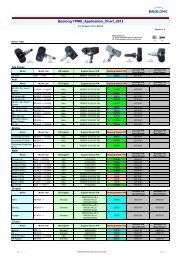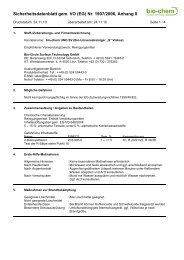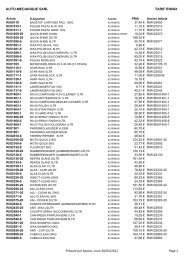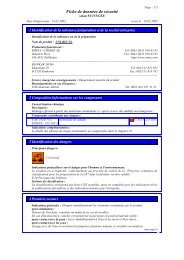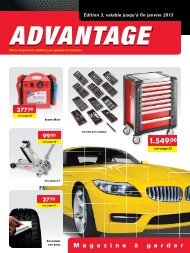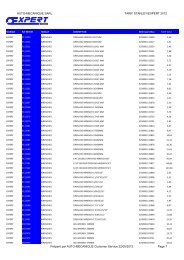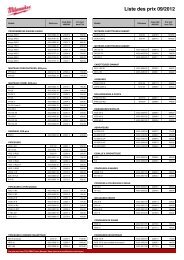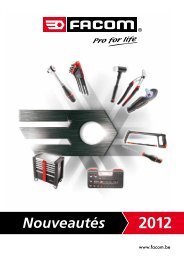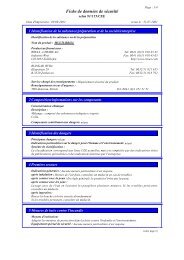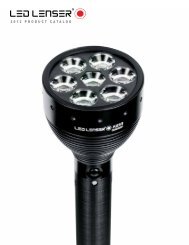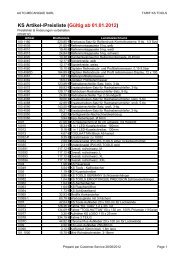REPAIR & SUPPLIES - Auto-Mecanique
REPAIR & SUPPLIES - Auto-Mecanique
REPAIR & SUPPLIES - Auto-Mecanique
You also want an ePaper? Increase the reach of your titles
YUMPU automatically turns print PDFs into web optimized ePapers that Google loves.
ONE-PIECE <strong>REPAIR</strong> PROCEDURES<br />
INJURY PREPARATION<br />
13. Once the size of the injury has been<br />
determined, select the appropriate<br />
repair material based on the size of<br />
the injury and the type of tire being<br />
repaired. Center the patch head<br />
over the injury on the inside of the<br />
tire and outline an area 1/4” larger<br />
than the patch to define the repair<br />
area.<br />
14. Using pre-buff rubber cleaner and<br />
an innerliner scraper, thoroughly<br />
clean the outlined area, removing<br />
all mold lubricants, dirt, and debris.<br />
15. Using a low speed buffer operating<br />
at no more than 5,000 rpm, buff<br />
the outlined area to an even, velvety<br />
RMA #1 textured finish (see below).<br />
Be careful not to buff through the<br />
innerliner and expose the cord body<br />
plies of the tire.<br />
16. Using a 500 rpm low speed air drill<br />
and the appropriate carbide cutter,<br />
clear and prepare the injury channel<br />
by drilling it 3 times from the inside<br />
of the tire and then 3 times from<br />
the outside of the tire. This will clear<br />
away any damaged cables and prepares<br />
the injury channel to receive<br />
the vulcanizing insert (stem portion<br />
of the repair unit). Vacuum away any<br />
buffing debris.<br />
<strong>REPAIR</strong> UNIT APPLICATION<br />
18. Relax the tire beads to their normal position. Remove the<br />
protective covering from the patch head and stem portions of<br />
the repair unit being careful not to touch the gum surfaces of<br />
the patch or stem.<br />
19. Place a drop of cement at the leading edge of the stem portion<br />
of the repair unit being careful not to puddle. This lubricates the<br />
repair unit as it is pulled through the injury channel.<br />
20. Insert the lead wire into the injury channel from the inside of the<br />
tire and pull it from the outside of the tire with a pair of pliers.<br />
Pull the repair unit steadily from the outside of the tire until the<br />
patch head is seated. Do not dimple the patch head by pulling<br />
too far.<br />
21. Using a roller stitcher, stitch<br />
the patch down firmly to the<br />
innerliner by working from the<br />
center outward making sure<br />
to remove all trapped air.<br />
22. Keeping the stem in a relaxed<br />
position, cut the stem about<br />
1/8" above the tread surface<br />
of the tire. Do not pull the<br />
stem while cutting.<br />
17. Using a cement dipped probe,<br />
coat the wall of the injury channel<br />
with chemical vulcanizing cement.<br />
Using the brush applicator, apply<br />
cement to the prepared area of the<br />
innerliner in a stippling motion being<br />
careful not to puddle the cement.<br />
Allow the cement to dry thoroughly<br />
before installing the repair unit.<br />
FINISHING THE <strong>REPAIR</strong><br />
23. Remount and inflate the tire following industry recommended<br />
procedures.<br />
24. Carefully inspect the repair for leaks and the tire for<br />
additional leaks or damage using the tire manufacturer or<br />
RMA guidelines. If all inspection criteria are met and no leaks<br />
are detected, the tire is ready to be put back into service.<br />
RMA Buffing Textures<br />
RMA #1 RMA #2 RMA #3 RMA #4 RMA #5 RMA #6<br />
Keeping You On the Road 113



